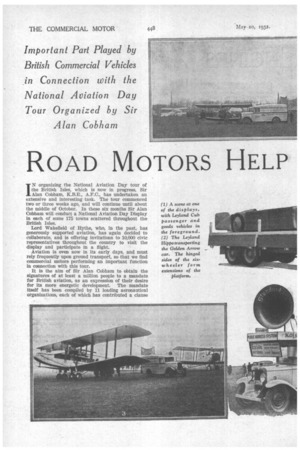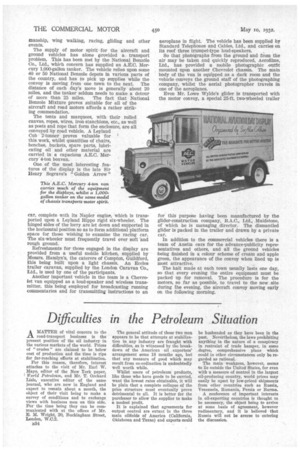ROAD MOTORS HELP VIATION PROPAGANDA
Page 46

Page 47

Page 48

If you've noticed an error in this article please click here to report it so we can fix it.
IN organizing the National Aviation Day tour of the British Isles, which is now in progress, Sir Alan Cobham, K.B.E., A.F.C., has undertaken an extensive and interesting task. The tour commenced two or three weeks ago, and will continue until about the middle of October. In these six months Sir Alan Cobham will conduct a National Aviation Day Display in each of some 175 towns scattered throughout the British Isles.
Lord Wakefield of Bythe, who, in the past, has generously supported aviation, has again decided to collaborate, and is offering invitations to 10,000 civic representatives throughout the country to visit the display and participate in a flight.
Aviation is even now in its early days, and must rely frequently upon ground transport, so that we find commercial motors performing an important function in connection with this tour.
It is the aim of Sir Alan Cobham to obtain the signatures of at least a million people to a mandate for British aviation, as an expression of their desire for its more energetic development. The mandate itself has been compiled by 11 leading aeronautical organizations, each of which has contributed a clause dealing with its own particular province. The intention is that at the close of the campaign this mandate will be placed before the proper authorities to impress upon the Government and municipalities the strength of public opinion in favour of aviation.
In order to arouse the kind of enthusiagm which the organizers need for the purpose of this mandate, it has been necessary to develop an imposing programme of flying in its many phases and to repeat this programme day by day at the many aerodromes visited.
No doubt in years to come, when an event of this kind is planned, all the necessary equipment, spare parts, tents, sleeping accommodation, enclosure posts, ropes, flying gear, etc., will be carried from place to place by air, but at the present stage of aviation's progress this is not quite practicable. The result is that road transport comes to the aid of the more youthful industry.
Even keeping requirements down to a minimum, the equipment necessary for the display amounts to several tons of dead weight. This, however, is not surprising, for the programme includes demonstrations of many types of aircraft, passenger flights, parachute descents, formation and exhibition flying, marks tranship, wing walking, racing, gliding and other events.
The supply of motor spirit for the aircraft and ground vehicles has alone provided a transport problem. This has been met by the National Be,nzOle Co., Ltd., which concern has supplied an &E.°. Mercury 1,000-gallon tanker. The vehicle relies upon some 40 or 50 National Benzole depots in various parts of the country, and has to pick up supplies while the convoy is moving from one town to the next. The distance of each day's move is generally about 20 miles, and the tanker seldom needs to make a detour of more than 23 miles. The fact that National Benzole Mixture proves suitable for all of the aircraft and road motors affords a rather striking commendation.
The tents and marquees, with their rolled canvas, ropes, wires, iron stanchions, etc., as well as posts and rope that form the enclosure, are all conveyed by road vehicle. A Leyland Cub 2-tonner proves valuable for this work, whilst quantities of chairs, benches, buckets, spare parts, lubricating oil and other material are carried in a capacious A.E.C. Mercury 4-ton boxvan.
One of the most interesting features of the display is the late Sir Henry Segrave's "Golden Arrow"
car, complete with its Napier engine, which is transported upon a Leyland Hippo rigid six-wheeler. The hinged sides of the lorry are let down and supported in the horizontal position so as to form additional platform space for those wishing to examine the racing car. The six-wheeler must frequently travel over soft 'and rough ground.
Refreshments for those engaged in the display are
kriovided from a useful mobile kitchen, supplied by essrs. Hamlyn's, the caterers of Compton, Guildford, 's being built upon a light chassis. An Eccles trailer caravan, supplied by the London Caravan Co., Ltd., is used by one of the participants.
Another important vehicle in the team is a Chevrolet van equipped as a loud-speaker and wireless transmitter, this being employed for broadcasting running commentaries and for transmitting instructions to an aeroplane in flight. The vehicle has been supplied by Standard Telephones and Cables, Ltd., and carries on its roof three trumpet-type loud-speakers.
So that photographs from the ground and from the air may be taken and quickly reproduced, Aerofilms, Ltd., has provided a mobile photographic outfit mounted upon another Chevrolet chassis. The main body of the van is equipped as a dark room and the vehicle conveys the ground staff of the photographing company, whilst the aerial photographer travels in one of the aeroplanes.
Even Mr. Lowe Wylde's glider is transported with the motor convoy, a special 25-ft. two-wheeled trailer
for this purpose having been manufactured by the glider-construction company, B..A.C., Ltd., Maidstone, of which he is managing director. The dismantled glider is packed in the trailer and drawn by a private car.
In addition to the commercial vehicles there is a team of Austin cars for the advance-publicity representatives and others, and all the ground vehicles being finished in a colour scheme of cream and apple green, the appearance of the convoy when lined up is most attractive.
The halt made at each town usually lasts one day, so that every evening the entire equipment must be packed up for removal. The procedure is for the motors, so far as possible, to travel to the new site during the evening, the aircraft convoy moving early on the following morning.




























































































